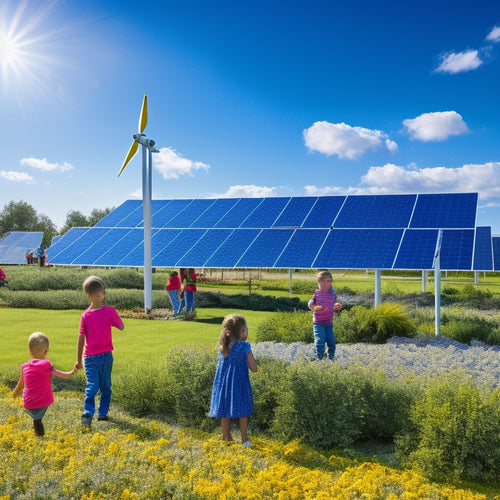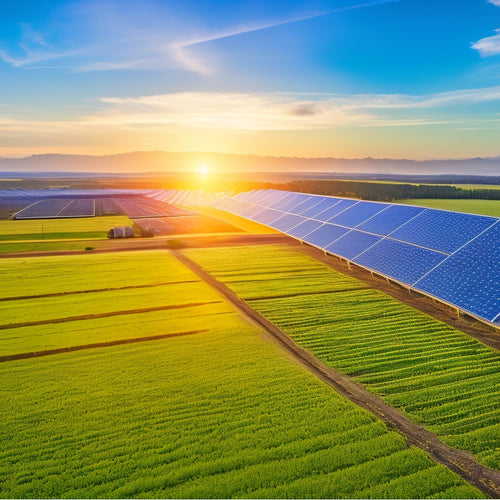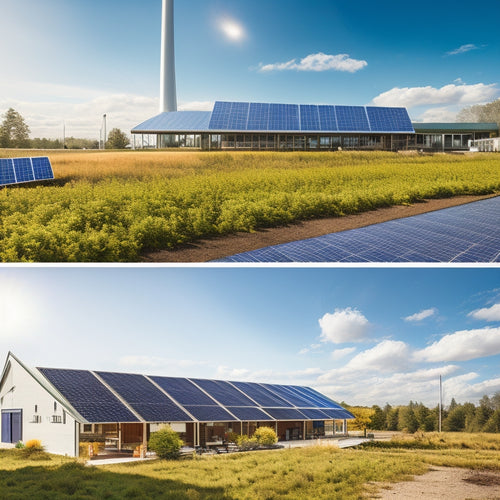
Calculating the Number of Solar Panels Needed for the Average Home
Share
To calculate the number of solar panels you'll need, start by analyzing your energy requirements, considering your daily electricity usage, appliance wattage, and seasonal variations. Next, evaluate your roof's solar potential, examining its size, orientation, and shading. Understanding solar panel efficiency is also essential, as different types offer varying performance levels. By calculating your total energy usage and dividing it by the individual panel wattage, you'll arrive at the required number of panels. However, factors like roof size, shape, and material, as well as local building codes, will further influence your system's size and layout - and that's just the beginning of your solar expedition.
Key Takeaways
- Determine daily energy consumption by analyzing past electricity bills and identifying appliance wattage and usage hours.
- Evaluate roof space and solar potential by measuring size, orientation, and angle, and conducting a shading analysis.
- Calculate total wattage required to meet energy needs based on daily consumption and system sizing factors.
- Divide total wattage by individual panel wattage to determine the number of panels needed, considering roof space limitations.
- Consult with a solar professional to verify calculations and optimize the solar system for maximum energy production and cost efficiency.
Determining Your Energy Requirements
Determining Your Energy Requirements
About 30 kilowatt-hours (kWh) of electricity are consumed daily in an average American home. To calculate the number of solar panels you need, you must assess your energy requirements. This involves identifying your energy sources and calculating your daily energy usage.
Start by making a list of your household appliances, including refrigerators, air conditioners, lighting, and electronics. Note their wattage and the number of hours they're used daily. Multiply the wattage by the usage hours to get the total daily energy consumption in watt-hours (Wh). For example, a 100W light bulb used for 8 hours consumes 800Wh or 0.8kWh.
Add up the energy consumption of all appliances to get your total daily energy requirement. You can also use your past electricity bills to estimate your average daily energy usage.
Be sure to take into account seasonal variations, as energy consumption tends to be higher during winter and summer months. By accurately determining your energy requirements, you'll be able to calculate the right number of solar panels to meet your needs and reduce your reliance on traditional energy sources.
Assessing Your Roof's Solar Potential
Now that you've calculated your daily energy requirements, it's time to evaluate whether your roof can accommodate a solar panel system that meets those needs.
Analyzing your roof's solar potential involves evaluating its solar orientation and performing a shading analysis.
You'll need to determine the orientation of your roof, considering the direction it faces (south, west, east, or north) and its angle (pitch). A south-facing roof with an angle between 30° and 40° is ideal for solar panels. If your roof doesn't meet these criteria, you can still install solar panels, but the system's efficiency might be affected.
Next, conduct a shading analysis to identify any obstructions that could cast shadows on your roof. This includes trees, buildings, and other structures that could block sunlight.
You can use online tools or consult with a solar panel professional to perform a detailed shading analysis. By evaluating your roof's solar potential, you'll be able to determine the best placement and number of solar panels required to meet your energy needs.
Understanding Solar Panel Efficiency
As you prepare to install a solar panel system, understanding the efficiency of these panels becomes vital. Efficiency ratings vary among solar panel types, and it's important to know how they impact your energy production.
Solar panel efficiency is measured by how well a panel converts sunlight into electricity. A higher efficiency rating means more power per hour of sunlight. Here are four key aspects to evaluate:
-
Monocrystalline silicon panels: 15-20% efficient, high-performance, and expensive.
-
Polycrystalline silicon panels: 12-15% efficient, mid-range performance, and moderately priced.
-
Thin-film panels: 7-14% efficient, lower performance, and budget-friendly.
- Bifacial panels: 15-22% efficient, high-performance, and designed to capture light from both sides.
When choosing a solar panel system, assess the efficiency ratings and the space available for installation. Higher efficiency panels may be more expensive, but they can generate more power in smaller spaces.
Understanding these factors will help you make an informed decision and maximize your energy production.
Calculating Your Energy Usage
You'll need to calculate your daily energy consumption, measured in kilowatt-hours (kWh), to determine the right size of your solar panel system.
Your energy usage patterns, including the time of day and season, also play an essential role in this calculation.
Daily Energy Consumption
Within your home's walls, a plethora of devices and appliances consume electrical energy, and calculating your daily energy consumption is essential to determining how many solar panels you'll need.
To get an accurate calculation, you'll need to know how much energy your home uses daily.
Here are some key areas to focus on:
-
Lighting: Calculate the total wattage of your light bulbs and the number of hours they're used daily.
-
Appliances: Determine the energy consumption of your refrigerator, oven, washer, and dryer.
-
Electronics: Add up the energy usage of your TV, computer, and other electronic devices.
- Heating and Cooling: Consider the energy required to heat and cool your home, including your HVAC system and any space heaters or air conditioners.
Energy Usage Patterns
To accurately calculate your energy usage, it's essential to understand your energy usage patterns. Your daily energy consumption is influenced by various factors, including your behavioral habits and energy conservation practices.
For instance, do you turn off lights and appliances when not in use, or do you leave them on for convenience? Do you use energy-efficient LED bulbs or traditional incandescent ones? These habits greatly impact your energy usage and must be taken into account.
Analyzing your energy usage patterns helps identify areas for improvement, allowing you to make adjustments that reduce your energy consumption. This, in turn, enables you to determine the correct size of the solar panel system you need.
By understanding your energy usage patterns, you can optimize your energy conservation efforts and maximize the benefits of solar power. Take note of your energy-intensive activities, such as laundry or cooking, and adjust your schedule accordingly.
Factors Affecting Solar Panel Quantity
You'll need to evaluate two key factors when determining the number of solar panels required for your average home: your roof's size and shape, and your energy consumption patterns.
The amount of available roof space will impact the number of panels you can install, while your energy usage habits will influence the total wattage you need to generate.
Roof Size and Shape
Across your roof's surface, multiple factors converge to determine the number of solar panels you'll need, and roof size and shape top the list. The larger your roof, the more panels you can fit, but its shape also plays a significant role. A rectangular roof with a simple layout can accommodate more panels than a complex, multi-angled roof.
To maximize your solar panel installation, consider the following key factors:
-
Roof orientation: A south-facing roof receives the most sunlight, making it ideal for solar panels. East- and west-facing roofs can also work, but north-facing roofs are less suitable.
-
Roof materials: Confirm your roof is made of a material that can support the weight of solar panels, such as asphalt shingles, metal, or concrete tiles. Avoid roofs with fragile materials like slate or clay tiles.
-
Obstacles and shading: Trees, chimneys, vents, and skylights can cast shadows on your roof, reducing the available space for solar panels.
- Roof pitch and angle: A roof with a pitch between 30° and 40° is ideal for solar panels, as it allows for peak energy production.
Energy Consumption Patterns
Your roof's unique characteristics have a significant impact on the number of solar panels you can install, but they're only half the equation. The other half is your energy consumption patterns, which play a vital role in determining how many panels you'll need. Understanding your energy usage helps you identify areas where you can make behavioral changes to reduce your reliance on non-renewable energy sources.
| Appliance | Energy Consumption (kWh) | Seasonal Variation |
| Refrigerator | 1.5 - 2.5 | Higher in summer, lower in winter |
| Air Conditioner | 2 - 5 | Higher in summer, negligible in winter |
| Water Heater | 3 - 5 | Consistent throughout the year |
| Lighting | 0.5 - 1.5 | Higher in winter, lower in summer |
| Electric Oven | 2 - 4 | Higher during holidays, lower during weekdays |
Sizing Your Solar Panel System
Calculating the ideal size of your solar panel system requires a thorough analysis of your energy needs and available roof space.
You'll need to take into account factors such as your energy consumption patterns, roof size and orientation, and local building codes.
To determine the best size of your solar panel system, follow these key steps:
-
Assess your energy needs: Review your past utility bills to determine your average daily energy consumption.
-
Evaluate your roof space: Measure your roof's size and orientation to determine how many solar panels can fit.
-
Examine local building codes: Check with your local government to confirm compliance with building codes and regulations.
- Research solar incentives and financing options: Look into available rebates, tax credits, and financing options to make your solar panel system more affordable.
Putting It All Together
Now that you've gathered all the necessary information, it's time to put the pieces together and determine the ideal solar panel system size for your home.
You've calculated your energy usage, assessed your roof's solar potential, and considered local building codes and regulations. Next, factor in solar incentives, such as the federal solar investment tax credit (ITC), which can greatly reduce the upfront cost of your system.
You may also want to investigate financing options, like loans or power purchase agreements, to make your solar investment more manageable.
Using your calculations, determine the total wattage required to meet your energy needs. Then, divide that number by the wattage of each solar panel to find the total number of panels needed.
Consider the physical space available on your roof and adjust your system size accordingly. Finally, consult with a solar professional to review your calculations and verify your system is optimized for maximum energy production and cost savings.
Frequently Asked Questions
Can I Install Solar Panels on a Rented Property?
You'll need to obtain your landlord's permission before installing solar panels on a rented property, and consider negotiating a solar panel agreement that outlines the terms, including ownership and maintenance responsibilities.
How Long Does It Take to Install a Solar Panel System?
You'll typically spend 1-3 days on the installation process, but the overall installation timeline can take 2-6 months, depending on permits, inspections, and utility approvals, before you're generating clean power and saving on your energy bills.
Can I Add More Panels to My Existing System?
You're part of the 90% of homeowners who can expand their existing solar setup. To maximize energy consumption, assess your current panel efficiency and identify underutilized roof space, then add more panels to enhance your system's overall performance.
Do Solar Panels Work During Power Outages?
You'll be glad to know that solar panels can work during power outages if you've got solar battery integration; this setup guarantees a steady supply, minimizing the power outage impact and keeping your lights on when the grid goes dark.
Are Solar Panels Covered Under Homeowner's Insurance?
You'll be relieved to know that your solar panel system is typically covered under your homeowner's insurance policy, providing solar panel coverage against damage or theft, and you should review your policy to guarantee it includes this important protection.
Conclusion
By now, you've calculated your energy requirements, assessed your roof's solar potential, and understood solar panel efficiency. Let's put it all together. For example, consider a 2,000 sq. ft. home in California with an average energy usage of 900 kWh/month. Assuming a roof with a 30% shading loss and 250-watt solar panels with 20% efficiency, you'd need approximately 24-28 panels to meet your energy needs. Get ready to utilize the power of the sun and start saving on your electricity bill!
Related Posts
-

Solar Power for Community Energy Independence
Solar power is essential for your community's energy independence, offering both environmental and economic benefits....
-

Solar Power for Reducing Carbon Footprint
Solar power is an effective strategy for reducing your carbon footprint. By adopting solar energy, you can cut greenh...
-

Off-Grid Solar Solutions for Eco-Conscious Businesses
Off-grid solar solutions offer you a path to both sustainability and substantial cost savings. By adopting these syst...


